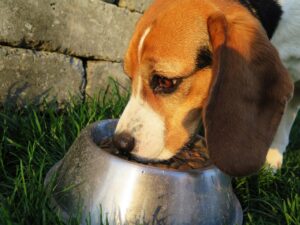
In recent years, awareness about food allergies in dogs has grown significantly. Much like humans, dogs can develop allergies to certain ingredients in their diet, leading to a range of health issues. Recognizing the symptoms of food allergies is crucial for ensuring your canine companion’s well-being.
What Causes Food Allergies in Dogs?
Food allergies in dogs occur when their immune system mistakenly identifies a protein in their food as harmful. Common allergens include beef, chicken, dairy, eggs, wheat, soy, and corn. However, dogs can be allergic to any protein they have been exposed to over time.
Top Symptoms of Dog Food Allergies
Identifying food allergies in dogs can be challenging, as the symptoms often overlap with other conditions. However, there are some telltale signs that can indicate a food allergy.
1. Itchy Skin and Dermatitis
One of the most common symptoms of a food allergy is itchy skin, also known as pruritus. Dogs may scratch, bite, or lick their skin excessively, leading to redness, inflammation, and eventually skin infections. Dermatitis can appear anywhere on the body but is often found on the face, ears, paws, and belly.
2. Gastrointestinal Issues
Food allergies can lead to various gastrointestinal symptoms, such as vomiting, diarrhea, and excessive gas. Dogs may also experience bloating, nausea, or a decrease in appetite. Chronic issues like intermittent diarrhea or soft stools can be a red flag for a food allergy.
3. Ear Infections
Recurrent ear infections are another common symptom of food allergies. Dogs with food allergies may suffer from ongoing ear problems, characterized by waxy discharge, redness, and a foul odor. These infections can cause discomfort and may become chronic if left untreated.
4. Respiratory Symptoms
Though less common, some dogs with food allergies may exhibit respiratory symptoms such as coughing, sneezing, or wheezing. These symptoms can sometimes be mistaken for environmental allergies or other respiratory conditions.
5. Behavioral Changes
Food allergies can also lead to behavioral changes in dogs. Due to discomfort and irritation, affected dogs may become more irritable, anxious, or lethargic. Owners may notice changes in their dog’s sleeping patterns or energy levels.
6. Chronic Paw Licking or Chewing
Dogs with food allergies often lick or chew their paws excessively. This behavior is usually a response to itching or discomfort caused by the allergy. Over time, this can lead to raw, irritated skin and secondary infections.
7. Hot Spots
Hot spots, or acute moist dermatitis, are areas of inflamed skin that become red, hot, and painful. They can develop rapidly and are often caused by a combination of itching, scratching, and licking. Food allergies are a common underlying cause of hot spots.
8. Hives or Facial Swelling
In some cases, dogs with food allergies may develop hives, which are raised, itchy bumps on the skin. Facial swelling, particularly around the eyes and muzzle, can also occur. These symptoms require immediate veterinary attention.
Diagnosing Dog Food Allergies
If you suspect your dog has a food allergy, it is essential to consult with a veterinarian for a proper diagnosis. The vet may recommend an elimination diet trial, which involves feeding your dog a novel protein and carbohydrate source that they have not previously been exposed to. This diet is usually maintained for 8-12 weeks to observe any changes in symptoms.
The Elimination Diet Process
During the elimination diet, all treats, table scraps, and flavored medications should be avoided to ensure accurate results. If symptoms improve, the vet may gradually reintroduce previous foods to identify the specific allergen. This process can be time-consuming, but it is the most reliable way to diagnose food allergies in dogs.
Managing Dog Food Allergies
Once a food allergy has been identified, managing it involves avoiding the offending ingredient. This may require switching to a hypoallergenic diet or a prescription diet recommended by your veterinarian. Owners should read dog food labels carefully to avoid potential allergens.
Hypoallergenic Dog Food Options
There are various hypoallergenic dog foods available on the market, including those with novel proteins like duck, venison, or kangaroo. Hydrolyzed protein diets, where proteins are broken down into smaller components that are less likely to trigger an allergic reaction, are another option.
Preventing Food Allergies in Dogs
While it may not be possible to prevent food allergies entirely, there are steps owners can take to minimize the risk. Introducing a variety of proteins and carbohydrates during the puppy stage can help reduce the likelihood of developing allergies later in life. Additionally, maintaining a healthy diet and regular veterinary check-ups can support overall health and well-being.
Conclusion
Food allergies in dogs can lead to a range of uncomfortable and potentially serious symptoms. By understanding the common signs and seeking veterinary advice, owners can help manage their dog’s allergies and improve their quality of life. With the right diet and care, dogs with food allergies can live happy, healthy lives.
#ChatGPT assisted in the creation of this article.







